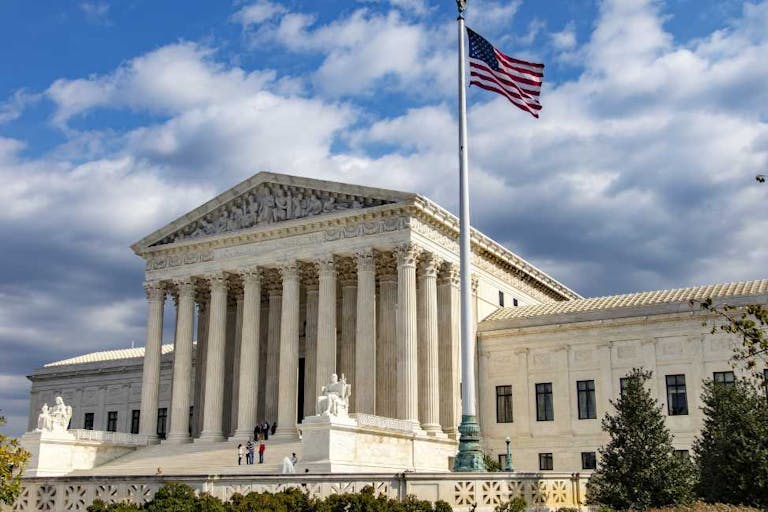
Baby born via emergency C-section to save her and her mother
Angeline Tan
·
Supreme Court ‘punts’ Idaho emergency room abortion case back to lower court
After a brief leak of the decision documents yesterday on the Court’s website, the Supreme Court of the United States today formally issued its guidance in the Moyle v. United States and Idaho v. United States cases by choosing to return them to a lower court.
The ruling lifts a stay on an injunction limiting enforcement of Idaho’s Defense of Life Act previously put in place by a federal district court order. This means Idaho hospitals receiving Medicaid funding must allow abortions to be committed as “stabilizing care” in compliance with the Emergency Medical Treatment and Labor Act (EMTALA). However, the Idaho Family Policy Council stated after news of the leak yesterday: “Because ‘medical emergency’ exceptions have proven just as effective as ‘life of the mother’ exceptions in restricting access to elective abortions, we do not anticipate that the abortion rate in Idaho [will] increase as a result of this ruling.”
The Biden Department of Justice (DOJ) sued Idaho in 2022, claiming that the state’s Defense of Life Act protecting preborn children from abortion violates EMTALA, claiming that “stabilizing care” could include abortion. Idaho asked the Supreme Court to intervene, and the court agreed. In the meantime, the Court had stayed the injunction, allowing the Defense of Life Act to take effect. Now that the Court has sent the cases back to the Ninth Circuit for review, the stay on that injunction is no longer in effect.
However, that injunction put in place by a district court and upheld by the Ninth Circuit is very narrow. It reads: “During the pendency of this lawsuit, the State of Idaho will be enjoined from enforcing Idaho Code § 18- 622 to the extent that statute conflicts with EMTALA-mandated care” (emphasis added). This would therefore be in extremely limited circumstances.
Idaho’s Defense of Life Act allows for abortion when a mother’s life is at risk, and in cases of rape or incest.
“I concur in the Court’s decision today to vacate its stay and dismiss the writ of certiorari before judgment as improvidently granted,” Justice Elena Kagan wrote, with Justices Sonia Sotomayor and Ketanji Brown Jackson concurring. “I do so because Idaho’s arguments about EMTALA do not justify, and have never justified, either emergency relief or our early consideration of this dispute. With this Court’s writ of certiorari dismissed, the lower courts can proceed with this litigation in the regular course. And with this Court’s stay dissolved, the District Court’s preliminary injunction will again take effect. That will prevent Idaho from enforcing its abortion ban when the termination of a pregnancy is needed to prevent serious harms to a woman’s health.”
Justice Amy Coney Barrett, along with Justice Brett Kavanaugh and Chief Justice John Roberts, also agreed to dismiss the case, albeit for different reasons. “Because the shape of these cases has substantially shifted since we granted certiorari, I concur in the Court’s judgment dismissing the writ as improvidently granted,” Barrett wrote, adding, “I am now convinced that these cases are no longer appropriate for early resolution.”
Barrett also noted an issue that many have pointed to as the reasoning for why this is only a temporary victory for the Biden administration, writing, “[P]etitioners have raised a difficult and consequential argument, which they did not discuss in their stay applications, about whether Congress, in reliance on the Spending Clause, can obligate recipients of federal funds to violate state criminal law.”
She also wrote that this will not prevent Idaho from protecting preborn lives in the majority of situations, which is addressed later in this article.
Justice Jackson partially dissented, saying that the case should not have been dismissed as improvidently granted but instead should have been decided by the Court. “This months-long catastrophe was completely unnecessary. More to the point, it directly violated federal law, which in our system of government is supreme,” she wrote. She continued:
We cannot simply wind back the clock to how things were before the Court injected itself into this matter. Our intervention has already distorted this litigation process. We permitted Idaho’s law to go into effect by staying the District Court’s injunction in the first place, then allowed this matter to sit on our merits docket for five months while we considered the question presented.
It is too little, too late for the Court to take a mulligan and just tell the lower courts to carry on as if none of this has happened. As the old adage goes: The Court has made this bed so now it must lie in it—by proceeding to decide the merits of the critical pre-emption issue this case presents.
She then claimed that “pregnant patients” in Idaho “experiencing emergency medical conditions remain in a precarious position,” and that “as long as we refuse to declare what the law requires, pregnant patients in Idaho, Texas, and elsewhere will be paying the price.”
Justice Samuel Alito wrote the dissenting opinion, joined by Justices Clarence Thomas and Neal Gorsuch. Alito argued that EMTALA requires not just pregnant patients’ lives to be protected, but the lives of their preborn children as well. He also agreed with Jackson that the court should not be punting the decision back to the Ninth Circuit, although Jackson and Alito clearly have different views on how the case should have been decided.
“Recognizing the flaws in the Government’s theory and Idaho’s ‘strong’ likelihood of success, this Court stayed the preliminary injunction pending appeal on January 5. And, wisely or not, the Court also took the unusual step of granting certiorari before Idaho’s appeal was heard by the Ninth Circuit,” he wrote. “Now the Court dismisses the writ and, what is worse, vacates the stay. This about-face is baffling. Nothing legally relevant has occurred since January 5. And the underlying issue in this case — whether EMTALA requires hospitals to perform abortions in some circumstances — is a straightforward question of statutory interpretation. It is squarely presented by the decision below, and it has been exhaustively briefed and argued.”
He added, “Apparently, the Court has simply lost the will to decide the easy but emotional and highly politicized question that the case presents. That is regrettable.”
Alito, in his dissent, also took the initiative of analyzing the issue of EMTALA requiring emergency room abortions (emphasis added):
… the right to refuse medical treatment without consent does not entail the right to demand treatment that is prohibited by law. Cancer patients have the right to refuse treatment that their doctors recommend, but they do not have a right to obtain whatever treatment they want, such as the administration of a drug that cannot legally be used in this country.
Likewise here, a woman’s right to withhold consent to treatment related to her pregnancy does not mean that she can demand an abortion. For these reasons, the text of EMTALA conclusively shows that it does not require hospitals to perform abortions.
Alito is correct; intentionally and directly killing a preborn child is not the standard of care for pregnancy-related emergencies. An early delivery, where a preborn child is not intentionally killed, is not considered an induced abortion — even if the child dies secondarily as a result of prematurity. Other legitimate medical treatments during emergency situations (like ectopic pregnancies and miscarriages) are also legal — in every state, not just Idaho.
Just a month after Roe v. Wade was reversed by the Supreme Court in June 2022, the Biden administration issued guidance specifically regarding “pregnant patients,” noting that EMTALA must from then on include abortion as a “stabilizing treatment” to be provided by emergency rooms, and made several demands upon hospital employees.
It also claimed that, based on its definition of an “emergency department,” that “it is likely that the labor and delivery unit of a hospital could meet the definition of a dedicated emergency department.”
Article continues below
Dear Reader,
In 2026, Live Action is heading straight where the battle is fiercest: college campuses.
We have a bold initiative to establish 100 Live Action campus chapters within the next year, and your partnership will make it a success!
Your support today will help train and equip young leaders, bring Live Action’s educational content into academic environments, host on-campus events and debates, and empower students to challenge the pro-abortion status quo with truth and compassion.
Invest in pro-life grassroots outreach and cultural formation with your DOUBLED year-end gift!
In other words, by classifying hospital labor and delivery units as “emergency departments,” the Biden administration appeared to be attempting to force all hospitals — under penalty of a loss of federal funding — to commit abortions. However, the administration’s attempts to do so via EMTALA were problematic, and it later made significant concessions before the Court.
Interestingly, the Biden administration originally argued before the Court that an abortion for reasons of “mental health” may be required as a “stabilizing treatment” under EMTALA. The administration later backtracked on this and other issues, as these are clearly beyond EMTALA’s scope. Justice Barrett noted this in her opinion (emphases added):
At the merits stage, however, the United States disclaimed these interpretations of EMTALA. First, it emphatically disavowed the notion that abortion is ever required as stabilizing treatment for mental health conditions…. That is an important concession: If restricted to conditions posing serious jeopardy to a woman’s physical health, the Government’s reading of EMTALA does not gut Idaho’s Act*
Second, the United States clarified that federal conscience protections, for both hospitals and individual physicians, apply in the EMTALA context. Tr. of Oral Arg. 87–89. That is another critical point: It alleviates Idaho’s concern that the Government’s interpretation of EMTALA would strip healthcare providers of conscience protections.
Barrett’s footnote adds, “The United States also clarified that if pregnancy seriously jeopardizes the woman’s health postviability, EMTALA requires delivery, not abortion. Brief for United States 10; Tr. of Oral Arg. 75. And it emphasized that EMTALA requires abortion only in an ’emergency acute medical situation,’ where a woman’s health is in jeopardy if she does not receive an abortion ‘then and there.’ Tr. of Oral Arg. 79–80. These two temporal points also narrow the scope of EMTALA’s potential conflict with Idaho’s Act” (emphasis added).
Abortions in the second or third trimesters often take days to complete. A delivery by induction during this time frame would assist the woman more quickly in a true emergency situation. And typically, it is later in pregnancy (second and third trimesters) that a woman would experience some type of “emergency acute medical situation,” not earlier. Emergency delivery — not abortion — is the typical course of action after all else has been tried, or in cases where an infection has begun.
Live Action founder and president Lila Rose noted in a press release:
In states like Idaho, doctors are already empowered to provide necessary stabilizing care for mothers facing life-threatening situations. These medical professionals can exercise their reasonable judgment to perform interventions that, while tragic, may lead to the unintended death of the preborn child. This is fundamentally different from abortion—the direct and intentional killing of an innocent human being in the womb.
Federal law does not mandate emergency room doctors to commit abortions. In cases where premature delivery is required to save the mother’s life, this is not considered an abortion. It is a necessary medical intervention where the primary intent is to save lives, not end them….
The Supreme Court reached the wrong decision today by failing to rule that abortion is not medical care.
Alliance Defending Freedom (ADF) issued a press release with a statement from Idaho Attorney General Raúl Labrador on the ruling, which expressed optimism about the long-term potential of the case. Labrador stated (emphasis added):
The Supreme Court sent the case back to the 9th Circuit today after my office won significant concessions from the United States that Justice Barrett described as ‘important’ and ‘critical. Today, the court said that Idaho will be able to enforce its law to save lives in the vast majority of circumstances while the case proceeds.
The Biden administration’s concession that EMTALA will rarely override Idaho’s law caused the Supreme Court to ask the 9th Circuit for review in light of the federal government’s change in position. Justice Barrett wrote, those concessions mean that Idaho’s Defense of Life Act ‘remains almost entirely intact.’ The 9th Circuit’s decision should be easy. As Justice Alito explained well: the Biden administration’s ‘preemption theory is plainly unsound.’
I remain committed to protect unborn life and ensure women in Idaho receive necessary medical care, and I will continue my outreach to doctors and hospitals across Idaho to ensure that they understand what our law requires. We look forward to ending this administration’s relentless overreach into Idahoans’ right to protect and defend life.
Idaho Chief of Constitutional Litigation and Policy Josh Turner, who argued the case before the Supreme Court, added (emphasis added):
I could not be more proud of what our office has accomplished in this case so far. We forced the Biden administration to make major concessions before the Supreme Court that it did not want to make, and those concessions are going to save many unborn lives. The people of Idaho should not be fooled by the misleading headlines in the media. Instead, I encourage everyone to read the court’s opinions for themselves.
The court may have decided to ‘punt’ today on the merits given the Biden administration’s ‘important’ and ‘critical’ concessions, but I have zero doubt after reading the decision, after standing before the justices and answering their questions, and after listening to the DOJ’s best arguments to defend the Biden administration’s legally untenable position, that Idaho’s Defense of Life Act is not preempted by EMTALA and will be vindicated in full.
Finally, Alliance Defending Freedom Senior Counsel and Vice President of Appellate Advocacy John Bursch concluded that they will continue fighting for life. “Both Idaho’s law and the Emergency Medical Treatment and Active Labor Act seek to protect the lives of women and their unborn children, and the consistency between those laws makes us confident about the future of this case,” he said.
“As Justice Barrett noted in her opinion, ‘even with the preliminary injunction in place, Idaho’s ability to enforce its law remains almost entirely intact.’ The Biden administration can’t manipulate federal law to wipe out state protections for unborn children and force emergency room doctors to perform abortions,” Bursch added. “Under Idaho’s law, doctors will continue to provide care to women experiencing ectopic pregnancies, miscarriages, and life-threatening conditions. We’ll continue to assist the state of Idaho and bring a rightful end to the administration’s unlawful overreach and protect the people’s freedom to preserve life.”
Special thanks to Live Action researcher and staff writer Bettina DiFiore for her assistance with the research for this article.
Live Action News is pro-life news and commentary from a pro-life perspective.
Contact editor@liveaction.org for questions, corrections, or if you are seeking permission to reprint any Live Action News content.
Guest Articles: To submit a guest article to Live Action News, email editor@liveaction.org with an attached Word document of 800-1000 words. Please also attach any photos relevant to your submission if applicable. If your submission is accepted for publication, you will be notified within three weeks. Guest articles are not compensated (see our Open License Agreement). Thank you for your interest in Live Action News!

Angeline Tan
·
Politics
Nancy Flanders
·
Politics
Bridget Sielicki
·
Politics
Stefano Gennarini, J.D. and Kelly Heilman, J.D.
·
Politics
Bridget Sielicki
·
Politics
Angeline Tan
·
International
Cassy Cooke
·
Analysis
Cassy Cooke
·
Analysis
Cassy Cooke
·
Analysis
Cassy Cooke
·
Analysis
Cassy Cooke
·